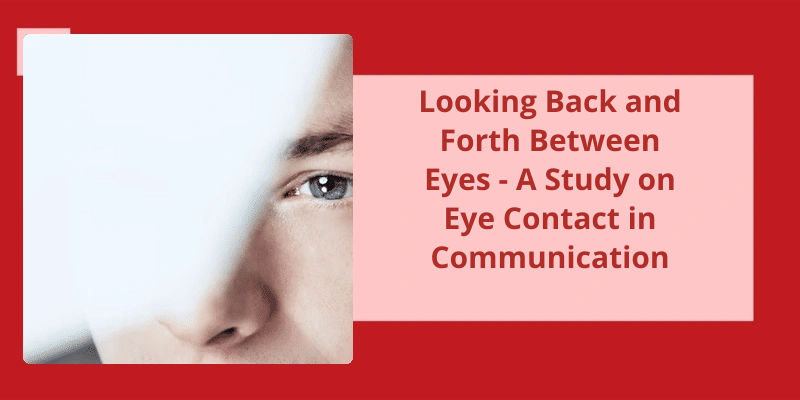Looking back and forth between eyes has been a common practice among humans for centuries. It’s a form of communication that helps people establish a connection with one another. The eyes are often considered the windows to the soul, and looking into someone's eyes is believed to reveal their true intentions and emotions. Throughout history, poets, artists, and musicians have depicted the powerful emotions that can be conveyed through eye contact. In today's digital age, where so much communication takes place through screens, the act of looking into someone's eyes has taken on a renewed significance. It’s become a powerful tool for building relationships and establishing trust, both in personal and professional settings.
What Is the Eye Movement in Psychology?
Eye movements are an important subject of study in psychology because they’ve been found to be associated with a wide range of cognitive processes. Eye tracking techniques have been used to investigate how people process visual information, from basic perceptual processes to more complex cognitive processes such as attention, memory, and decision-making. Eye movement patterns have been found to vary depending on the task demands, the visual stimuli, and the individuals goals and strategies.
One of the most prominent findings in eye movement research is the existence of fixations and saccades. Fixations are periods of time during which the eyes are relatively stable and focused on a particular point in space. Saccades, on the other hand, are rapid movements of the eyes that quickly redirect the gaze to a new location. The alternation between fixations and saccades allows the visual system to sample the visual world in an efficient and flexible manner.
For example, studies have shown that eye movements can reveal the syntactic structure of sentences, as people tend to fixate longer on words that are syntactically more important (e.g., the verb in a sentence). For instance, people tend to follow the gaze direction of others, and this social cue can influence where people fixate their eyes.
Abnormal eye movements have been found to be an indicator of neurological and psychiatric disorders such as Alzheimers disease, Parkinsons disease, and schizophrenia. Eye tracking has also been used to assess visual attention in children with developmental disorders such as autism and attention-deficit/hyperactivity disorder (ADHD).
Psychologists have used eye tracking techniques to investigate a wide range of cognitive processes and to develop new diagnostic tools for neurological and psychiatric disorders.
Body language plays a vital role in communication and understanding it can help you gauge someone’s emotions and thoughts. Amongst the many cues, looking sideways is one such gesture that holds considerable significance. In this article, we’ll delve deeper into what it means when someone looks side to side and why it’s a crucial non-verbal cue to comprehend.
What Does It Mean When Someone Looks Side to Side?
The act of looking side to side is deeply rooted in human behavior and psychology. It’s a non-verbal cue that conveys a lot of information and can be used to interpret someones mood, feelings, and intentions. Looking sideways is a complex gesture, and it’s meaning can vary depending on the context and situation.
When someone looks to the side frequently, it could be a sign of nervousness or anxiety. They might be feeling stressed out or uncomfortable in the situation, and they’re trying to find a way to alleviate their discomfort. Alternatively, if someone is lying or being deceptive, they might look to the sides a lot to avoid eye contact and prevent the listener from detecting their lies. In some cases, someone might use this behavior as a manipulative tactic to distract or confuse those around them.
However, if someone looks away from the speaker, it could be an indicator of comfort or submissiveness. They might not want to appear confrontational or intimidating, and so they avoid direct eye contact. Additionally, if someone is interested in a topic, they might look to the side to gather their thoughts before responding. It could also signal that they’re deep in thought or considering something carefully.
Looking askance is another non-verbal behavior that can reveal someones feelings and thoughts. It suggests that the person is distrustful or unconvinced about something. They might be skeptical of the speaker or the information being presented. It could also indicate that they’re questioning the validity of a statement or decision and are hesitant to agree without further evidence or explanation.
It’s meaning can be ambiguous at times, and it’s important to consider the context and situation when interpreting this behavior. While it can indicate nervousness, deception, or skepticism, it can also convey comfort, deep thought, and attentiveness. Being aware of these nuances can help us communicate more effectively and understand others better.
Conclusion
Looking back and forth between eyes is an essential aspect of human communication. It’s through eye contact that we connect with others and establish trust, empathy, and understanding. From the moment we’re born, we seek out eye contact as a means of survival, and as we grow older, we use eye contact to convey our thoughts, feelings, and intentions. However, in today's digital world, we’re increasingly communicating through screens, which can detract from the powerful connections that come with eye contact. It’s vital that we continue to prioritize face-to-face communication and foster meaningful connections through eye contact. Remember, the eyes are the windows to the soul, and through them, we can forge lasting connections with those around us.






